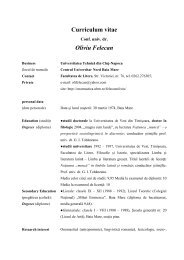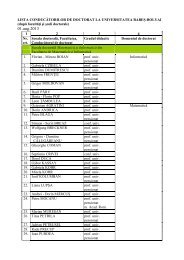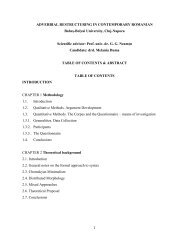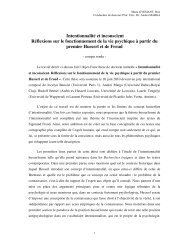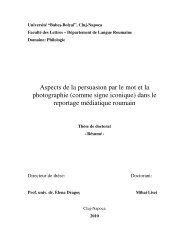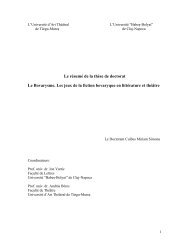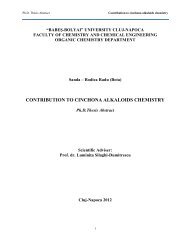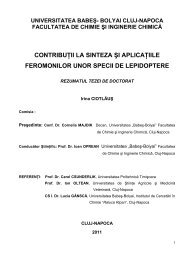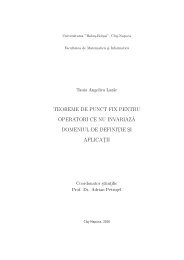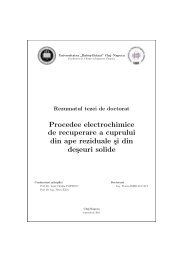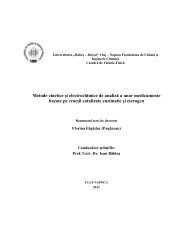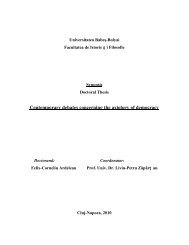The image of the communist torturer as reflected
The image of the communist torturer as reflected
The image of the communist torturer as reflected
You also want an ePaper? Increase the reach of your titles
YUMPU automatically turns print PDFs into web optimized ePapers that Google loves.
“BABEŞ-BOLYAI” UNIVERSITY CLUJ-NAPOCA<br />
FACULTY OF HISTORY AND PHILOSOPHY<br />
THE IMAGE OF THE COMMUNIST TORTURER AS<br />
REFLECTED IN THE MEMOIRS OF THE ROMANIAN<br />
CONCENTRATION CAMPS (1947-1989)<br />
Summary <strong>of</strong> <strong>the</strong> doctoral dissertation<br />
SCIENTIFIC ADVISOR: PhD CANDIDATE:<br />
Pr<strong>of</strong>. univ. dr. Doru RADOSAV Dumitru-Cătălin ROGOJANU<br />
1
TABLE OF CONTENTS<br />
I. STRUCTURE, RESEARCH METHODOLOGY AND SOURCES<br />
II. THE TEAR CUP OF THE GRIEVING MEMORY<br />
II. 1.Memoirs <strong>of</strong> <strong>the</strong> <strong>communist</strong> prison space. Terminological boundaries<br />
II.2. Incarceration memoirs: between history and literature<br />
II.3. <strong>The</strong> role and functions <strong>of</strong> incarceration memoirs<br />
II.4. Conclusions<br />
III.HISTORIOGRAPHY OF THE MEMOIRS OF THE ROMANIAN GULAG. A SHORT<br />
PRESENTATION<br />
III. 1. Introduction<br />
III. 2. Memoirs <strong>of</strong> Piteşti<br />
III. 3. Memoirs <strong>of</strong> Aiud<br />
III. 4. Memoirs <strong>of</strong> Jilava<br />
III. 5. Memoirs <strong>of</strong> Gherla<br />
IV. THE PORTRAIT OF THE ROMANIAN COMMUNIST TORTURER<br />
IV. 1. Torture and <strong>torturer</strong>. Conceptual boundaries<br />
IV. 2. <strong>The</strong> language and gestures <strong>of</strong> <strong>torturer</strong>s<br />
IV. 3. A bird's-eye view <strong>of</strong> <strong>the</strong> pr<strong>of</strong>ile <strong>of</strong> <strong>the</strong> Romanian <strong>communist</strong> <strong>torturer</strong><br />
IV.4. <strong>The</strong> portrait <strong>of</strong> <strong>the</strong> <strong>communist</strong> <strong>torturer</strong> <strong>as</strong> <strong>reflected</strong> in <strong>the</strong> “grieving and emotional<br />
memory” <strong>of</strong> Elisabeta Rizea. An interpretative analysis<br />
V.TYPOLOGY OF THE COMMUNIST TORTURERS<br />
V. 1. Multiple categories <strong>of</strong> <strong>torturer</strong>s<br />
V. 2. Bad-“good” <strong>torturer</strong>s<br />
V. 3. Illiterate, frustrated, voyeuristic and reconverted <strong>torturer</strong>s<br />
V. 4. Zealots, careerist and sadist <strong>torturer</strong>s<br />
V.5. <strong>The</strong> inquirer-defendant relationship<br />
V.6. Conclusions<br />
VI. MEMORIZING AND REMEMORIZING THE SUFFERING FROM THE GULAG.<br />
HISTORICAL AND PSYCHOHISTORICAL ASPECTS<br />
VI.1. Memorizing and rememorizing <strong>the</strong> suffering from <strong>the</strong> Romanian gulag<br />
VI. 2. Physical and emotional suffering in <strong>the</strong> USSR and Poland. Methods <strong>of</strong> torture<br />
VI. 3. <strong>The</strong>oretical and methodological coordinates <strong>of</strong> history and psychohistory<br />
VI. 4. Historical and psychohistorical considerations on <strong>the</strong> Romanian <strong>communist</strong><br />
torturing<br />
VI. 5. Conclusions<br />
VII. CASE STUDY<br />
PROFILES OF TORTURERS: VASILE CIOLPAN AND PETRE GOICIU<br />
VII. 1. <strong>The</strong> physical, behavioral and moral pr<strong>of</strong>ile <strong>of</strong> V<strong>as</strong>ile Ciolpan. Several<br />
psychohistorical <strong>as</strong>pects<br />
VII. 2. <strong>The</strong> pr<strong>of</strong>ile <strong>of</strong> <strong>the</strong> “Gherla satrap”: Petrache Goiciu<br />
VIII. WOMEN-TORTURERS IN THE ROMANIAN GULAG<br />
VIII. 1. Sadica Vida Nedici<br />
VIII. 2. Elena Tudor: <strong>The</strong> kindhearted “Diri” or <strong>the</strong> cruel „Caligula”<br />
VIII. 3. “Modest” women-<strong>torturer</strong>s<br />
CONCLUSIONS<br />
BIBLIOGRAPHY<br />
List <strong>of</strong> annexes<br />
2
Keywords: <strong>the</strong> pr<strong>of</strong>ile <strong>of</strong> <strong>the</strong> <strong>communist</strong> <strong>torturer</strong>, <strong>the</strong> typology <strong>of</strong> <strong>torturer</strong>s, <strong>the</strong> memoirs<br />
<strong>of</strong> concentration camps, memorizing and rememorizing suffering, <strong>torturer</strong> V<strong>as</strong>ile<br />
Ciolpan, <strong>torturer</strong> Petre Goiciu, women-<strong>torturer</strong>s, Vida Nedici, Elena Tudor<br />
Through this research we aim to recreate <strong>the</strong> pr<strong>of</strong>ile <strong>of</strong> <strong>the</strong> Romanian <strong>communist</strong><br />
<strong>torturer</strong> b<strong>as</strong>ed mainly on <strong>the</strong> memoirs from concentration camps, <strong>as</strong> well <strong>as</strong> on archival<br />
sources, books, studies and scholarly articles from Romania and from abroad. <strong>The</strong><br />
premise <strong>of</strong> our scientific endeavor h<strong>as</strong> been to provide a conceptual, analytical and<br />
interpretative framework to <strong>the</strong> topic <strong>of</strong> torturing by following a few guidelines emerged<br />
from o<strong>the</strong>r investigative perspectives or <strong>as</strong> a result <strong>of</strong> <strong>the</strong> different bibliographic tools<br />
used by Romanian historians and researchers. 1<br />
One <strong>of</strong> <strong>the</strong> re<strong>as</strong>ons we chose this topic w<strong>as</strong> to bring up into academic debate <strong>the</strong><br />
reprehensible actions <strong>of</strong> <strong>the</strong> former representatives <strong>of</strong> <strong>the</strong> <strong>communist</strong> repressive machine<br />
and <strong>the</strong> manner in which <strong>the</strong>y were depicted and judged by memoirists. Also, through this<br />
dissertation we aim to indirectly point out to <strong>the</strong> need <strong>of</strong> condemning communism not<br />
only at declaratory and „<strong>of</strong>ficial” levels, but by emph<strong>as</strong>izing <strong>the</strong> depositions <strong>of</strong> <strong>the</strong><br />
victims who recalled <strong>the</strong>ir convulsive experiences in memoirs or through oral history<br />
interviews.<br />
At present, <strong>the</strong> Romanian society cannot <strong>as</strong>sume its p<strong>as</strong>t without a historical<br />
ra<strong>the</strong>r than political or judicial „trial”, because only <strong>the</strong> historian can make nuanced<br />
analyses and interpretations concerning <strong>the</strong> wardens who persecuted innocent people.<br />
<strong>The</strong> main concern <strong>of</strong> our research w<strong>as</strong> to outline <strong>the</strong> pr<strong>of</strong>iles <strong>of</strong> well-known <strong>torturer</strong>s<br />
starting from <strong>the</strong> depiction <strong>of</strong> <strong>the</strong>ir physical and behavioral features. We also had in mind<br />
<strong>the</strong> urgent need <strong>of</strong> „not forgetting”, or <strong>as</strong> Paul Goma would say, <strong>of</strong> „not being silent”<br />
about <strong>the</strong> members <strong>of</strong> <strong>the</strong> <strong>communist</strong> repressive machine.<br />
1 Unlike o<strong>the</strong>r analysts <strong>of</strong> <strong>the</strong> Romanian Gulag, Ruxandra Cesereanu h<strong>as</strong> brought a fundamental<br />
contribution to <strong>the</strong> presentation and investigation <strong>of</strong> <strong>the</strong> topic <strong>of</strong> torturing, using a v<strong>as</strong>t bibliographic<br />
material in <strong>the</strong> form <strong>of</strong> memoirs <strong>as</strong> well <strong>as</strong> foreign literature which revolves around <strong>the</strong> repressive<br />
mechanisms used by totalitarian regimes.<br />
3
First and foremost, we deemed that it w<strong>as</strong> necessary to make a descriptive and<br />
interpretative analysis <strong>of</strong> <strong>the</strong> physical and moral pr<strong>of</strong>ile <strong>of</strong> <strong>the</strong> Romanian oppressor, <strong>as</strong><br />
well <strong>as</strong> a thorough inquiry into <strong>the</strong> language and gestures <strong>of</strong> <strong>torturer</strong>s drawing on <strong>the</strong><br />
pattern developed by researcher François Thom. Secondly, we intended to outline a<br />
portrait <strong>of</strong> <strong>the</strong> <strong>torturer</strong> both from a historical and a psychohistorical perspective, although<br />
in Romania <strong>the</strong>re is high wariness <strong>of</strong> bringing up a topic which requires an insight at <strong>the</strong><br />
crossroads between history and psychohistory or history and psychoanalysis.<br />
Ano<strong>the</strong>r guideline <strong>of</strong> this dissertation w<strong>as</strong> to draft a few categories <strong>of</strong> <strong>torturer</strong>s, to<br />
penetrate <strong>the</strong> complex „mechanism” between investigator and defendant and to present<br />
this relationship by referring to <strong>the</strong> c<strong>as</strong>e study <strong>of</strong> Elisabeta Rizea and its <strong>torturer</strong>s.<br />
A special emph<strong>as</strong>is w<strong>as</strong> placed on memorizing and rememorizing <strong>the</strong> suffering<br />
inflicted in <strong>the</strong> Romanian Gulag and on <strong>the</strong> manner in which <strong>the</strong> prisoners related to <strong>the</strong>ir<br />
traumatic p<strong>as</strong>t. Also, we deemed it necessary to present pr<strong>of</strong>iles <strong>of</strong> wardens, men and<br />
women, such <strong>as</strong> V<strong>as</strong>ile Ciolpan, Petrache Goiciu, Vida Nedici and Elena Tudor.<br />
It is worth noting that hi<strong>the</strong>rto, except for Ruxandra Cesereanu, Doina Jela,<br />
Andrei Muraru, Dumitru Lăcătuşu, Alin Mureşan, Mircea Stănescu, Florian Banu,<br />
Andrea Fürtös and Robert Fürtös, o<strong>the</strong>r historians and specialists in <strong>the</strong> Romanian Gulag<br />
did not focus so intensely on recreating <strong>the</strong> pr<strong>of</strong>iles <strong>of</strong> such <strong>torturer</strong>s. Hence, we aimed to<br />
perform a syn<strong>the</strong>sis <strong>of</strong> <strong>the</strong> study <strong>of</strong> Romanian <strong>communist</strong> wardens by revolving around<br />
<strong>the</strong> memoirs not so large in scope <strong>of</strong> <strong>the</strong> prison space, but which are at le<strong>as</strong>t self-evident<br />
through <strong>the</strong> approach undertaken and <strong>the</strong> selection and analysis <strong>of</strong> <strong>the</strong> pr<strong>of</strong>iles <strong>of</strong><br />
wardens.<br />
Through this dissertation we also aimed to outline <strong>as</strong> detailed <strong>as</strong> possible <strong>the</strong><br />
terminological boundaries <strong>of</strong> <strong>the</strong> incarceration memoirs, <strong>the</strong>ir role and functions, and how<br />
<strong>the</strong>se plausible sources are located within <strong>the</strong> confines <strong>of</strong> history and literature bearing<br />
more <strong>of</strong> a documentary-historical value than an es<strong>the</strong>tic-literary one.<br />
In our reflection we have not downplayed <strong>the</strong> broad presentation <strong>of</strong> <strong>the</strong><br />
autobiographic writings which contributed more or less to <strong>the</strong> recreation <strong>of</strong> <strong>the</strong> pr<strong>of</strong>ile <strong>of</strong><br />
<strong>the</strong> Romanian <strong>torturer</strong> and <strong>of</strong> o<strong>the</strong>r <strong>as</strong>pects <strong>as</strong> well, such <strong>as</strong> <strong>the</strong> way in which <strong>the</strong><br />
prisoners perceived <strong>the</strong> prison and <strong>the</strong> incarceration regime.<br />
4
For <strong>the</strong> sake <strong>of</strong> coherence and argumentation in a historical analysis we used<br />
research interrogations in order to achieve a concentration <strong>of</strong> <strong>the</strong> investigation field and<br />
to outline a generic design <strong>of</strong> <strong>the</strong> variables and concepts. Questions such <strong>as</strong>: How can we<br />
define a <strong>torturer</strong>? How many types <strong>of</strong> <strong>torturer</strong>s are <strong>the</strong>re? How did prisoners describe<br />
<strong>the</strong>m physically and morally? What kind <strong>of</strong> <strong>torturer</strong>s were, for instance, V<strong>as</strong>ile Ciolpan<br />
and Petrache Goiciu, all allowed us to have a structured approach and to devise a few<br />
clear and coherent research hypo<strong>the</strong>ses.<br />
Before studying <strong>the</strong> members <strong>of</strong> <strong>the</strong> <strong>communist</strong> repressive machine or before<br />
undertaking any scientific research one must have a good command <strong>of</strong> <strong>the</strong> specific<br />
research methodology. 2 Since this dissertation pertains to <strong>the</strong> field <strong>of</strong> social sciences, and<br />
using extensive interpretation and analysis, we performed qualitative research 3 in a<br />
thorough examination <strong>of</strong> <strong>the</strong> knowledge on this field <strong>of</strong> study. Methodological<br />
interdisciplinarity w<strong>as</strong> used in order to reflect <strong>the</strong> multiple perspectives <strong>of</strong> this study –<br />
historical and psychological (psychohistorical), and to represent <strong>the</strong> complexity <strong>of</strong> <strong>the</strong><br />
topic.<br />
Ano<strong>the</strong>r research method referred to <strong>the</strong> hermeneutics <strong>of</strong> <strong>the</strong> incarceration<br />
memoirs and archival documents (<strong>the</strong> different minutes, autobiographies, statements and<br />
reports found in <strong>the</strong> personnel records <strong>of</strong> <strong>torturer</strong>s such <strong>as</strong> V<strong>as</strong>ile Ciolpan). In <strong>the</strong>se<br />
personnel files useful information can help retrace <strong>the</strong> biographical pr<strong>of</strong>iles <strong>of</strong> <strong>the</strong><br />
wardens, also providing references about <strong>the</strong> physical and behavioral pr<strong>of</strong>iles <strong>of</strong> <strong>the</strong><br />
former inquisitors.<br />
Setting up <strong>the</strong> relationship between cause and effect (<strong>the</strong> method <strong>of</strong> historical<br />
causality) when studying <strong>the</strong> <strong>communist</strong> <strong>torturer</strong>s reflects <strong>the</strong> need to have a thorough<br />
2 In <strong>the</strong> analysis <strong>of</strong> historical topics such <strong>as</strong> <strong>the</strong> study <strong>of</strong> <strong>the</strong> Romanian <strong>communist</strong> <strong>torturer</strong>s, with an<br />
emph<strong>as</strong>is on <strong>the</strong> research techniques and methods, <strong>the</strong> following works are indispensable: E. H. Carr, What<br />
is history ?, London : Penguin, 1961; Charles H. Feinstein and Mark Thom<strong>as</strong>, Making History Count. A<br />
Primer Quantitative Methods for Historians, Cambridge: Cambridge University Press, 2002; Alun.<br />
Munslow, Deconstructing History, London: Routledge, 1997; Jerzy Topolsky, Metodologia istoriei,<br />
Traducere de Anca Ţapu, Bucureşti : Ştiinţificã şi Enciclopedicã, 1987.<br />
3 Jonathan Grix, in <strong>the</strong> book Demistificarea cercetării postuniversitare. De la m<strong>as</strong>terat la doctorat,<br />
Traducere de Nicolae Melinescu (under print), pp. 40-48, makes a clear delimitation between qualitative<br />
and quantitative research methods.<br />
5
understanding <strong>of</strong> <strong>the</strong>ir psychology and behaviour, to explain <strong>the</strong> degree <strong>of</strong> sympathy or<br />
antipathy between <strong>torturer</strong> and tortured and <strong>the</strong> mechanisms which generate a tacit<br />
preservation <strong>of</strong> this relationship or its brutal degradation. Analyzing <strong>the</strong> circumstances in<br />
which inquiries were organized in <strong>the</strong> <strong>communist</strong> prisons and <strong>the</strong> torture techniques<br />
inflicted upon <strong>the</strong> defendants – an analysis <strong>of</strong> that multiple causality referred to by Marc<br />
Bloch 4 – anticipates <strong>the</strong> answer to <strong>the</strong> why question.<br />
Examining <strong>the</strong> memoirs written by <strong>the</strong> former prisoners from <strong>the</strong> Romanian<br />
<strong>communist</strong> concentration camps gave us <strong>the</strong> opportunity to reflect deeply upon <strong>the</strong> way<br />
in which suffering is memorized and rememorized, and how <strong>torturer</strong>s are portrayed. One<br />
must not rely entirely on <strong>the</strong> testimonies <strong>of</strong> <strong>the</strong> defendants or <strong>of</strong> <strong>the</strong> <strong>torturer</strong>s because, by<br />
<strong>the</strong>ir nature, memoirs are <strong>of</strong>ten bi<strong>as</strong>ed. However, with a moderate sense <strong>of</strong> criticism, one<br />
can expect not to separate between true and false, but at le<strong>as</strong>t identify what is au<strong>the</strong>ntic<br />
(plausible), listen to <strong>the</strong>se „live sources” 5 and allow <strong>the</strong> victim to speak up. 6<br />
Some realities, such <strong>as</strong> <strong>the</strong> methods <strong>of</strong> torture and <strong>the</strong> abusive behavior <strong>of</strong> <strong>the</strong><br />
<strong>torturer</strong>s, cannot be contested, but it is necessary to meditate deeply upon <strong>the</strong> act <strong>of</strong><br />
memorizing and re-memorizing some events and historical actions by <strong>the</strong> prisoners from<br />
<strong>the</strong> <strong>communist</strong> prisons. <strong>The</strong> reinterpretation <strong>of</strong> <strong>the</strong> testimonies found in memoirs should<br />
take into account <strong>the</strong> emotions, fear and <strong>the</strong> desire for vengeance <strong>of</strong> <strong>the</strong> defendants, but<br />
should equally consider <strong>the</strong> emotional discharge, that catharsis <strong>of</strong> <strong>the</strong> soul that we,<br />
historians, <strong>of</strong>fer to <strong>the</strong> victims <strong>of</strong> <strong>the</strong> Romanian <strong>communist</strong> gulag. This drainage <strong>of</strong> <strong>the</strong><br />
4 A m<strong>as</strong>terful presentation <strong>of</strong> <strong>the</strong> research tools used by <strong>the</strong> historian (causality, observation, critique and<br />
historical analysis) w<strong>as</strong> made by Marc Bloch in his study Pledoarie pentru istorie, Traducere de George<br />
Cipăianu, Cluj-Napoca: Tribuna, 2007. <strong>The</strong> French text, Apologie pour l’histoire, ou métier d’historien, 2<br />
edition, Paris: Librairie Armand Colin, 1952 is available online at<br />
http://cl<strong>as</strong>siques.uqac.ca/cl<strong>as</strong>siques/bloch_marc/apologie_histoire/apologie_histoire.html. L<strong>as</strong>t accessed on:<br />
1 martie 2009.<br />
5 About memory <strong>as</strong> „live source” <strong>as</strong> compared to <strong>the</strong> archival documents said to be „dead sources” for <strong>the</strong><br />
historian, two fundamental works by Paul Ricoeur are recommended: Istorie şi adevăr, Bucureşti:<br />
An<strong>as</strong>t<strong>as</strong>ia, 1996 and Memorie, istorie, uitare, Traducere de Ilie Gyurcsik şi Margareta Gyurcsik,Timişoara:<br />
Amarcord, 2001.<br />
6 Doru Radosav, “De la mărturia orală la depoziţie sau două modalităţi de apropriere (<strong>as</strong>umpţie) a<br />
trecutului” in Anuarul de Istorie Orală, nr. X, Cluj-Napoca: Presa Universitară Clujeană, Cluj-Napoca,<br />
2008, p. 9.<br />
6
p<strong>as</strong>t by our confessors does not necessarily imply a loss <strong>of</strong> objective information because<br />
information is told by people and man is a complex and subjective human being. For this<br />
re<strong>as</strong>on, <strong>the</strong> historical critique 7 <strong>of</strong> <strong>the</strong> oral and written sources is indispensable to a study<br />
which <strong>as</strong>pires to be <strong>as</strong> close to reality <strong>as</strong> possible.<br />
<strong>The</strong> historian knows that his confessors can lie or commit an error, but what he<br />
actually wants is to make <strong>the</strong>m speak in order to be able to understand <strong>the</strong>m afterwards.<br />
Achieving a physical, moral and behavioral portrait <strong>of</strong> a <strong>communist</strong> <strong>torturer</strong> b<strong>as</strong>ed on<br />
memoirs implies a sound critique, a relevant analysis and interpretation instead <strong>of</strong> a mere<br />
reading <strong>of</strong> <strong>the</strong> various situations, because a source <strong>of</strong> any nature provides historical<br />
information provided that <strong>the</strong> historian can make a sense out <strong>of</strong> it and extract all its<br />
“historical essence”. <strong>The</strong>refore, <strong>the</strong> historian is bound to avoid deceit (misinformation)<br />
and <strong>the</strong> misrepresentation <strong>of</strong> <strong>the</strong> p<strong>as</strong>t, 8 meaning that he must refrain from presenting false<br />
information or truncated truth, although sometimes even false sources can reveal a dose<br />
<strong>of</strong> trustworthiness.<br />
Concerning <strong>the</strong> research methodology, <strong>the</strong> researcher interested in <strong>the</strong> topic <strong>of</strong><br />
<strong>communist</strong> <strong>torturer</strong>s in general or in a c<strong>as</strong>e study will have in mind, according to <strong>the</strong><br />
epistemological and ontological results he envisaged, a descriptive and explanatory<br />
analysis b<strong>as</strong>ed on <strong>the</strong> inductive method (when we performe <strong>the</strong> c<strong>as</strong>e study first, i.e. V<strong>as</strong>ile<br />
Ciolpan) and <strong>the</strong> deductive method (when we do <strong>the</strong> reverse, from a typology <strong>of</strong> <strong>torturer</strong>s<br />
towards a specific c<strong>as</strong>e). When describing events, facts or stories related to <strong>torturer</strong>s <strong>the</strong><br />
historian proves a good understanding <strong>of</strong> <strong>the</strong> reality in which his subjects lived and<br />
wishes to make it nuanced, to provide detailed information about <strong>the</strong>ir pr<strong>of</strong>iles, for<br />
instance. When trying to explain some historical circumstances centered on <strong>the</strong> <strong>torturer</strong>s,<br />
<strong>the</strong> researcher tests his good investigative skills and his ability to criticize <strong>the</strong> sources,<br />
while trying to extrapolate or to correlate <strong>the</strong> results <strong>of</strong> his c<strong>as</strong>e study with o<strong>the</strong>rs.<br />
Independent <strong>of</strong> <strong>the</strong> level <strong>of</strong> analysis: macro (<strong>the</strong> types <strong>of</strong> <strong>the</strong> Romanian <strong>communist</strong><br />
<strong>torturer</strong>) or micro (c<strong>as</strong>e study), <strong>the</strong> historian must have clear-cut research guidelines and<br />
exercise historical critique throughout <strong>the</strong> entire investigation.<br />
7 See chapter “Critica”, pp. 101-158 in Marc Bloch, op.cit.<br />
8 For fur<strong>the</strong>r details, see subchapter “Pe urmele minciunii şi ale erorii”, in Marc Bloch, Pledoarie (...), pp.<br />
112-132.<br />
7
<strong>The</strong> method <strong>of</strong> historical critique equals doubt, according to exegetes such <strong>as</strong><br />
Marc Bloch. Applied to <strong>the</strong> study <strong>of</strong> <strong>communist</strong> <strong>torturer</strong>s this method guides us through a<br />
great thirst for knowledge, for <strong>as</strong>king questions and for trying to find answers. A great<br />
force pushed us forward and drove us into our research towards gnosiological<br />
interrogations such <strong>as</strong>: What were <strong>the</strong> <strong>communist</strong> <strong>torturer</strong>s, human or “be<strong>as</strong>ts”? How did<br />
<strong>the</strong>y treat <strong>the</strong>ir victims? How did former prisoners see <strong>the</strong>m and what w<strong>as</strong> <strong>the</strong> relationship<br />
between prisoners and <strong>the</strong>ir oppressors? <strong>The</strong>se are only a few questions to which we<br />
cannot answer without a comprehensive knowledge <strong>of</strong> <strong>the</strong> historical critique and <strong>of</strong> <strong>the</strong><br />
o<strong>the</strong>r techniques and methods referred to earlier.<br />
A rigorous and sound research methodology is impossible without making appeal<br />
to sources and <strong>the</strong>ir rational examination according to <strong>the</strong> working hypo<strong>the</strong>ses,<br />
interrogations, variables and levels <strong>of</strong> analysis developed in this doctoral dissertation.<br />
We b<strong>as</strong>ed our research on multiple sources: primary inedited archival documents<br />
(personnel records), secondary edited sources (general literature, memoirs, studies and<br />
articles) and even artistic films, such <strong>as</strong> După amiaza unui torţionar and Binecuvântată<br />
fii, închisoare, both directed by Lucian Pintilie, or documentaries such <strong>as</strong> Memorialul<br />
durerii created by Lucia Hossu Longin.<br />
Faced with a “cobweb” <strong>of</strong> books, analyses and memoir syn<strong>the</strong>ses, we had to make<br />
a careful selection <strong>of</strong> <strong>the</strong> <strong>of</strong>ten fragmented information about <strong>the</strong> pr<strong>of</strong>ile, typology and<br />
language <strong>of</strong> <strong>the</strong> <strong>torturer</strong>s. Many prison memoirs lacked almost completely any reference<br />
to inquirers and wardens, which forced us to use only partially <strong>the</strong> bibliographic material<br />
at our disposal.<br />
Although some sources were hardly studied because we decided that a careful<br />
internal and external critical review 9 w<strong>as</strong> redundant, in <strong>the</strong> c<strong>as</strong>e <strong>of</strong> archival documents<br />
we searched for <strong>the</strong> purpose for which <strong>the</strong>y were written, <strong>the</strong> historical context (origins)<br />
in which <strong>the</strong>y were issued and <strong>the</strong> writing style.<br />
<strong>The</strong> hermeneutics <strong>of</strong> <strong>the</strong> documents made us understand better what stands<br />
beyond <strong>the</strong> primary texts, how <strong>the</strong>y can be analyzed from <strong>the</strong> standpoint <strong>of</strong> <strong>the</strong> person<br />
who issued <strong>the</strong>m and <strong>the</strong> socio-historical context in which <strong>the</strong>y were drafted. Thus, we<br />
9 <strong>The</strong> au<strong>the</strong>nticity <strong>of</strong> sources (external critique) and <strong>the</strong> research <strong>of</strong> <strong>the</strong>ir credibility (internal critique) w<strong>as</strong><br />
addressed by Jerzy Topolsky, op. cit., pp. 298-310.<br />
8
must have in mind that most <strong>of</strong> <strong>the</strong> sources which refer to <strong>the</strong> <strong>communist</strong> <strong>torturer</strong>s reflect<br />
a mentality, a coerced and a coercive society, a repressive system in which many<br />
documents were drafted ei<strong>the</strong>r under <strong>the</strong> physical and emotional coercion inflicted by <strong>the</strong><br />
<strong>torturer</strong>s or were counterfeited in order to incriminate <strong>the</strong> defendants and exonerate <strong>the</strong><br />
inquirers. 10 <strong>The</strong>refore, it is imperative to interrogate <strong>the</strong> sources and observe what <strong>the</strong>y<br />
communicate beyond quantitative information, knowing for sure that <strong>communist</strong> sources<br />
were designed with a clear goal in mind: to legitimate <strong>the</strong> regime and <strong>the</strong> members <strong>of</strong> its<br />
repressive machine.<br />
As sources are created by people, <strong>the</strong> perception <strong>of</strong> an event varies from one<br />
society and individual to <strong>the</strong> o<strong>the</strong>r. In our c<strong>as</strong>e, though, <strong>the</strong> collective conscience <strong>of</strong> <strong>the</strong><br />
defendants reflects <strong>the</strong>ir specific features. What a defendant states about his <strong>torturer</strong>s all<br />
<strong>the</strong> o<strong>the</strong>r defendants will confirm under a different form, with o<strong>the</strong>r emotions and in a<br />
different style because individual memory under communism evolved gradually into a<br />
grieving collective memory. By means <strong>of</strong> <strong>the</strong> critique <strong>of</strong> testimonials, <strong>the</strong> history <strong>of</strong><br />
<strong>torturer</strong>s and <strong>the</strong>ir victims becomes an emotional reality <strong>of</strong> a community, relying on<br />
mental procedures, a subtle art <strong>of</strong> transcending <strong>the</strong> substance <strong>of</strong> <strong>the</strong> sources and a need to<br />
doubt and to understand.<br />
Historical critique also implies a continuous correlation and comparison between<br />
different sources so that information from one source can be verified or infirmed by o<strong>the</strong>r<br />
sources (for instance, analogies between several testimonies will be made in order to<br />
define <strong>the</strong> similarities and differences between <strong>the</strong> depositions <strong>of</strong> former prisoners: Are<br />
<strong>the</strong>y narrating <strong>the</strong> same facts? What is <strong>the</strong> style <strong>of</strong> <strong>the</strong> confessions?)<br />
<strong>The</strong> crosscheck <strong>of</strong> sources through <strong>the</strong> comparative method 11 is a test <strong>of</strong> truth<br />
because, <strong>as</strong> times goes by, <strong>the</strong> memory <strong>of</strong> people can mislead <strong>the</strong>m. Although <strong>the</strong> authors<br />
10 Footnote 3 from <strong>the</strong> study entitled „Reeducarea-posibile origini occidentale”, available at<br />
http://www.cns<strong>as</strong>.ro/documente/istoria_comunism/studii_articole/activitati_plan_intern/Originile%20reedu<br />
carii.pdf, l<strong>as</strong>t accessed: 20 martie 2010, researcher Luminiţa Banu states that “<strong>the</strong> archival documents<br />
created by <strong>the</strong> exponents <strong>of</strong> <strong>the</strong> totalitarian system must be analysed with great caution (particularly!) when<br />
<strong>the</strong>y were aimed at reinstating <strong>the</strong> “socialist legality”, <strong>as</strong> w<strong>as</strong> <strong>the</strong> c<strong>as</strong>e with <strong>the</strong> inquiry <strong>of</strong> <strong>the</strong> <strong>torturer</strong>s in<br />
Piteşti, and <strong>of</strong> Ţurcanu himself.”<br />
11 <strong>The</strong> comparative method used by historians in <strong>the</strong>ir researches is explained by Jerzy Topolsky, op. cit.,<br />
pp. 325-327.<br />
9
<strong>of</strong> memoirs were <strong>the</strong> direct witnesses <strong>of</strong> some events, <strong>the</strong> actual narration <strong>of</strong> facts can be<br />
altered by certain conditions: emotions, <strong>the</strong> fear <strong>of</strong> <strong>the</strong> victims towards <strong>the</strong>ir <strong>torturer</strong>s, <strong>the</strong><br />
beatings during <strong>the</strong> inquiries, <strong>the</strong> acuteness <strong>of</strong> perception, <strong>the</strong> different abuses inflicted<br />
upon <strong>the</strong>m (a defendant can narrate in greater detail <strong>the</strong> evolution <strong>of</strong> an inquiry than<br />
ano<strong>the</strong>r defendant if his memory, attention and interest were more acute at that moment),<br />
<strong>the</strong>ir social status, education, <strong>the</strong> cultural environment in which <strong>the</strong>y activated. Our role is<br />
to question <strong>the</strong> testimonies <strong>of</strong> <strong>the</strong> authors <strong>of</strong> memoirs, which means that throughout <strong>the</strong><br />
entire research we “psychologized <strong>the</strong> testimony” concluding that “<strong>the</strong>re is no good<br />
witness” but only “good or bad testimonies”. 12<br />
Historical observation 13 h<strong>as</strong> a fundamental role because <strong>the</strong> scope <strong>of</strong> knowledge<br />
<strong>of</strong> <strong>the</strong> witness-former prisoner covers only one <strong>as</strong>pect and one event – one person<br />
describes <strong>the</strong> language <strong>of</strong> <strong>the</strong> <strong>torturer</strong>, ano<strong>the</strong>r one remembers his physical and moral<br />
pr<strong>of</strong>ile – and thus, <strong>the</strong> individual is prevented from recreating facts by his ability to<br />
memorize or by his education and personality.<br />
In conclusion, emph<strong>as</strong>izing <strong>the</strong> re<strong>as</strong>ons which prompted us to choose <strong>the</strong> topic,<br />
structure, sources, research techniques and methods in studying <strong>the</strong> pr<strong>of</strong>ile <strong>of</strong> <strong>the</strong><br />
<strong>communist</strong> <strong>torturer</strong> is a useful scientific exercise for <strong>the</strong> researcher who is willing to carry<br />
out a reliable, balanced and unbi<strong>as</strong>ed study. As stated earlier, without research<br />
interrogations and without a good command <strong>of</strong> <strong>the</strong> methodological tools our scientific<br />
endeavor would have remained caught in a “raw” ph<strong>as</strong>e <strong>of</strong> mere presentation <strong>of</strong><br />
information. On <strong>the</strong> contrary, by taking an interdisciplinary approach, we were able to<br />
treat <strong>the</strong> topic <strong>of</strong> <strong>the</strong> <strong>communist</strong> <strong>torturer</strong>s in a deep and multifaceted way.<br />
12 Marc Bloch, op. cit., pp. 122-123.<br />
13 <strong>The</strong> general features <strong>of</strong> historical observation and <strong>the</strong> description <strong>of</strong> testimonies can be found in Marc<br />
Bloch, Pledoarie (…), pp. 69-90.<br />
10



